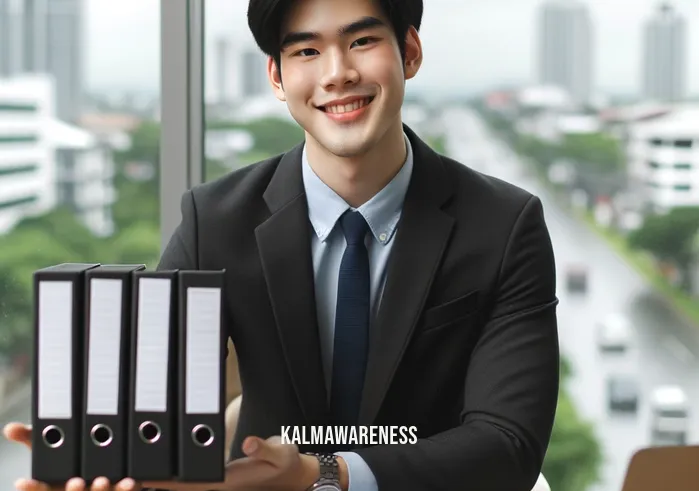Habit of Thought: Understanding Cognitive Patterns and Shaping Our Reality
The intricate workings of the human mind have fascinated scholars, psychologists, and thinkers for centuries. At the core of this fascination lies the concept of the “habit of thought.” These are the patterns and tendencies we form over time, which play a pivotal role in shaping our perception, our responses to external stimuli, and our overall understanding of the world. In this article, we’ll explore the depths of habitual thinking and its profound implications for our mental conditioning, thought processes, mindset habits, and overall emotional well-being.
The Essence of the Habit of Thought
The habit of thought refers to the recurring and automatic ways our mind processes information. Imagine a frequently traveled path in a forest. Over time, the repeated journey creates a clear, unmistakable trail. Similarly, our minds develop certain neural pathways through repeated thinking patterns. These patterns or habits can either be constructive, leading to growth and positivity, or they can be destructive, resulting in negative thought cycles.
The Impact on Cognitive Patterns
Our cognitive patterns encompass the various ways we process, store, and retrieve information. The habit of thought directly influences these patterns. For instance, if one constantly harbors negative thoughts about their abilities, they might develop a cognitive bias that overlooks their achievements and magnifies their failures.
Mental Conditioning: The Underlying Blueprint
Mental conditioning is akin to training your mind to think or feel a certain way, often as a response to specific situations or stimuli. Our habits of thought lay the foundation for this conditioning. To draw a parallel, consider how athletes train. Their repetitive actions, over time, condition their muscles to react in specific ways. Our mind works similarly, but with thoughts and emotions. By understanding and recognizing our habitual thinking, we can work towards reconditioning or strengthening our mental responses.
Thought Processes: The Journey of Reflection and Analysis
Every day, our minds are inundated with a deluge of information. The way we analyze, reflect upon, and interpret this information constitutes our thought processes. These processes are not standalone. They are intrinsically linked with our habits of thought. For instance, someone with a pessimistic habit of thought might view challenges as insurmountable obstacles, while an optimist might see them as opportunities.
The Tug of War Between Mindset Habits and Emotions
Our emotions and mindset habits are deeply intertwined. Emotions often drive our thinking patterns, and conversely, our mindset habits can evoke specific emotional responses. Consider the emotion of fear. If one has a habit of thought that often revolves around worst-case scenarios, even a minor setback might trigger disproportionate levels of anxiety or stress.
The Road Ahead
The exploration of the habit of thought is not just an academic endeavor. It holds tangible implications for our daily lives. By recognizing, understanding, and actively working on our thinking patterns, we can pave the way for better mental well-being, informed decision-making, and a more balanced emotional life.
In the subsequent segments, we will delve deeper into the strategies to reshape our habits of thought, the science behind mental conditioning, and the profound influence of our thinking tendencies on our overall well-being. The journey of understanding the mind is an enlightening one, offering tools and insights to create a more harmonious internal world.
For a more in-depth exploration of these facets and practical tips on nurturing a constructive habit of thought, continue reading in the next segment.

Expanding the Horizons of Habit of Thought
The realm of the human mind is vast, filled with a mosaic of interconnected thoughts, feelings, and experiences. Among these myriad aspects, the habit of thought stands as a beacon, guiding and influencing our daily actions and overall life trajectory. As we delve deeper into this topic, we’ll explore the multifaceted dimensions of thinking habits and their profound implications.
The Subtleties of Thinking Tendencies
While we discussed the foundational elements of the habit of thought in the previous segment, it’s essential to understand the subtleties that differentiate one person’s thinking tendencies from another. These tendencies can be:
- Intrinsic: Rooted deeply within one’s personality and inherent nature.
- Extrinsic: Developed due to external influences like societal norms or peer pressure.
- Temporal: Changing with time and evolving as one gains new experiences.
- Situational: Arising in specific contexts or scenarios.
- Learned: Acquired through education or exposure to certain stimuli.
Factors Influencing Habitual Thinking
Several factors play a crucial role in molding our habitual thinking. Here’s a breakdown of some of the most significant influences:
- Childhood Experiences: Early years have a lasting impact on how we perceive and process the world.
- Cultural Background: The culture we’re born into can dictate specific thought patterns and biases.
- Personal Traumas: Experiences of trauma can skew our thinking towards pessimism or constant fear.
- Educational Exposure: The education system and the kind of learning we’re exposed to can shape our analytical and critical thinking abilities.
- Peer Groups: The company we keep can influence our thought processes, for better or worse.
Habit of Thought: A Comparative Overview
| Aspect | Positive Habit of Thought | Negative Habit of Thought | Neutral Habit of Thought |
|---|---|---|---|
| Impact on Self-esteem | Boosts confidence and self-worth | Erodes self-belief | Neither uplifts nor demeans |
| Decision Making | Leads to informed, balanced choices | Often results in impulsive actions | Indecisive or overly cautious |
| Social Interactions | Enables constructive conversations | Can cause misunderstandings | Passive or non-committal |
| Emotional Health | Promotes positive emotional well-being | Leads to emotional turmoil | Neutral, can lean either way |
| Overall Outlook | Optimistic and forward-looking | Pessimistic and wary | Ambivalent |
Navigating the Landscape of Mental Conditioning
Mental conditioning is like the software operating within our brain’s hardware. Understanding this software—our habits of thought—can empower us to update, modify, or even rewrite certain parts of it. For those seeking to reshape their thinking tendencies, awareness is the first step. Recognizing existing patterns, questioning their origins, and assessing their impact on our lives can pave the way for change.
The Path Forward
Unraveling the depths of our thinking habits is a continuous journey, one that offers profound insights into our psyche. As we peel back the layers, we’re equipped to make informed choices, foster healthier relationships, and nurture a balanced emotional state.
In the next chapter, we’ll explore practical strategies and techniques to cultivate a constructive habit of thought, providing readers with actionable steps to harness the power of their mind. Dive in to unearth the treasures hidden within your thought processes and transform your world from the inside out.

Nurturing Positivity: The Inspirational Power of Habit of Thought
Habits of thought often define our daily experiences. They shape our realities, craft our perceptions, and even influence our future trajectories. Yet, amidst the myriad patterns of thinking, there lies a potent force capable of igniting change: inspiration. In this segment, we’ll explore the intersection of habitual thinking and the inspiring stories that fuel our pursuit of personal growth.
The Transformative Effect of Positive Thinking
It’s no secret that our thought processes impact our realities. But what’s often understated is the immense power held by optimistic thinking habits. As Helen Keller wisely remarked:
“Optimism is the faith that leads to achievement. Nothing can be done without hope and confidence.”
Embracing a positive habit of thought not only bolsters our mental well-being but also propels us forward, even during trying times.
Real-Life Inspirations: Stories that Resonate
Maya’s Journey: Maya, a young woman from a marginalized community, always found herself entrenched in negative thought patterns. Believing that her circumstances defined her destiny, she felt trapped. But an encounter with a mentor changed her mindset. The mentor introduced Maya to inspirational books and exercises to reshape her thinking habits. Today, Maya runs an NGO, focusing on education for underprivileged children, embodying the idea that a shift in thought can pave the path to profound transformation.
Sam’s Resilience: After facing a string of failures in his professional life, Sam was on the brink of giving up. His habitual thinking led him to believe he wasn’t cut out for success. Then, he stumbled upon a quote that changed his perspective:
“Our greatest glory is not in never falling, but in rising every time we fall.” – Confucius
Embracing this philosophy, Sam relentlessly pursued his dreams, eventually founding a start-up that now impacts thousands of lives.
The Enduring Power of Hope
Hope, when intertwined with our habits of thought, becomes a formidable force. It acts as a beacon, guiding us through turbulent waters and uncharted territories. Anne Frank, even in the bleakest of situations, encapsulated this sentiment by saying:
“Where there’s hope, there’s life. It fills us with fresh courage and makes us strong again.”
Instilling hope into our thinking habits not only empowers us to face challenges head-on but also encourages us to envision a brighter future.
Embracing Inspiration in Everyday Life
It’s essential to understand that inspiration isn’t solely derived from grand gestures or significant life events. It can be found in everyday moments, from a child’s laughter to the serene beauty of a sunset. The key lies in cultivating a habit of thought that remains open, receptive, and ever-curious. As Ralph Waldo Emerson aptly put:
“The only person you are destined to become is the person you decide to be.”
By choosing to seek inspiration and allow it to permeate our habitual thinking, we embark on a journey of perpetual growth and self-discovery.
Gazing Ahead: The Quest for Continuous Inspiration
Our exploration into the inspiring world of habits of thought unravels the deep-seated potential within us all. Recognizing the stories, quotes, and everyday moments that fuel our spirits is just the beginning. The true adventure lies in continuously seeking inspiration, letting it shape our thinking patterns, and translating it into meaningful action.
In the upcoming chapter, we’ll delve into the actionable strategies to foster a positive and inspired habit of thought, equipping readers with tools to manifest their dreams. Continue reading to navigate the transformative realm of the mind, where every thought holds the promise of a brighter tomorrow.

Decoding the Intricacies: A Deep Dive into Habit of Thought
Navigating the vast landscape of our minds, we encounter various thought patterns and tendencies. While we’ve previously touched upon the broader implications of the habit of thought, in this chapter, we aim to dissect it further, breaking it down to its elemental components. Using concise bullet points and lists, we’ll unravel the layers, making the complex notion of habitual thinking more accessible.
Key Elements of Habitual Thinking
Repetition: Thoughts that repeatedly occupy our minds solidify into habits.
Emotion: The feelings accompanying our thoughts—whether positive, negative, or neutral—play a pivotal role in determining their stickiness.
Belief Systems: Our core beliefs, often rooted in early life experiences or cultural upbringing, influence our habitual thinking.
External Influences: Events, people, and environments we’re exposed to can mold our thought patterns.
Advantages of Positive Thinking Habits
Mental Well-being: Foster a sense of contentment, reducing stress and anxiety.
Enhanced Problem-solving: Encourage a solution-oriented approach to challenges.
Better Interpersonal Relationships: Lead to constructive communication and understanding.
Higher Resilience: Equip individuals to bounce back from adversities with greater ease.
Increased Creativity: Open up pathways to innovative ideas and thinking.
Common Pitfalls of Negative Thinking Habits
- Stunted Growth: Pessimistic thinking can deter personal and professional development.
- Conflict in Relationships: Can lead to misunderstandings and strain in interpersonal ties.
- Reduced Productivity: Hamper efficiency and drive, leading to procrastination.
- Health Issues: Chronic negative thinking can contribute to mental and physical health problems.
- Limited Worldview: Prevent individuals from seeing the broader picture, leading to a narrow perspective.
Techniques to Cultivate Constructive Thought Habits
- Mindfulness Meditation: Focuses on being present, allowing one to recognize and shift negative thought patterns.
- Cognitive Behavioral Therapy (CBT): A structured approach to identify and replace detrimental thought habits with healthier ones.
- Affirmations: Positive statements repeated daily to reinforce constructive thinking.
- Journaling: Writing down thoughts can provide clarity and an avenue to reshape thinking.
- Exposure to Positivity: Surrounding oneself with optimistic influences, whether through books, media, or company.
The Interplay of Habitual Thinking with Daily Actions
- Decision-making: Our habits of thought directly influence the choices we make.
- Reactions to External Events: Determine whether we respond with calm, anxiety, aggression, or indifference.
- Interactions with Others: Shape our conversations, either fostering connection or discord.
- Personal Goals and Ambitions: Influence our aspirations and the zeal with which we pursue them.
Gearing Up for the Grand Finale
As we’ve embarked on this enlightening journey, diving deep into the world of habits of thought, we’ve discovered its myriad facets, from its foundational elements to its profound implications. As we approach our conclusion, the final chapter promises to encapsulate our learnings, offering actionable insights and a holistic understanding.
Continue reading to grasp the ultimate essence of habitual thinking, a cornerstone of human cognition, and embark on a transformative journey towards mastering the power of the mind.

Reflecting on the Journey: The Odyssey of Habit of Thought
As we stand on the cusp of concluding this enlightening expedition, we find ourselves enriched with knowledge, insights, and a profound understanding of the ‘habit of thought’. This concept, though intangible, weaves the fabric of our daily experiences, shaping our interactions, feelings, decisions, and ultimately, our destiny.
The Highlights Revisited
The Foundations: We embarked on this voyage by grounding ourselves in the basic constructs of habitual thinking, understanding its essence, and its implications.
The Deep Dive: Venturing deeper, we dissected the intricate layers of thinking habits, drawing inspiration from quotes, real-life stories, and the very essence of hope.
The Practical Blueprint: Equipped with this understanding, we charted out actionable strategies to cultivate positive thought patterns, ensuring a holistic and balanced mindset.
Applying Our Insights
Understanding the habit of thought is only half the battle. The true essence lies in its application. Here’s a brief guide to integrate these insights into your daily life:
- Self-awareness: Regularly check in with yourself, recognizing and challenging any negative thought patterns.
- Seek Inspiration: Surround yourself with positive influences—books, people, experiences—to continually nourish your mind.
- Engage in Self-reflection: Dedicate moments of your day to introspection, understanding your thinking tendencies, and realigning them if needed.
- Stay Educated: Revisit sections from our previous chapters to refresh your understanding or delve deeper into specific areas.
A Heartfelt Note to Our Readers
Thank you for accompanying us on this enlightening exploration into the world of habitual thinking. Your curiosity, engagement, and eagerness to learn have made this journey all the more rewarding. We are humbled by your dedication and are committed to bringing more insightful content in our subsequent editions.
The Road Ahead
We encourage you to explore other captivating topics on our platform. Every article, every story is crafted with you in mind, aiming to nourish the mind and enrich the soul.
And as you move forward, equipped with a deeper understanding of your thought patterns, remember to shine your light brightly, illuminating not just your path but also those of others you touch along the way.
Here’s to a future filled with positive habits of thought, boundless inspiration, and a continual journey of self-discovery!




